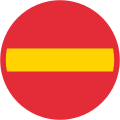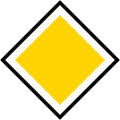Driving around in Sweden takes you to places outside the big cities. This is a good way to travel if you are interested in seeing some countryside.
Special requirements

All cars in Sweden must have their headlights on at all times. If you drive without lights you may find other drivers flashing their headlights at you to inform you.
From 1 December to 31 March Swedish registered cars in use are required by law to have either studded tires or un-studded winter friction tires. The tires must be marked, M+S, M-s, M.S, M&S, MS or Mud and Snow. This rule is valid only if the roads are considered to be in "winter conditions" by the local police, but that is so common in this period that you should not be without such tires.
Although foreign registered cars are formally exempt from this requirement, it is still strongly recommended when driving in Sweden during the winter. The police may stop foreign registered cars without winter tires on road safety grounds, if the conditions are too bad.
Be aware that there are streets in Stockholm where studded tires are banned.
Roads
The European road network goes through Sweden, and mostly have higher standard than national or local roads. Some important roads are:
- E4 – from Helsingborg (close to Malmö), to Stockholm and then all the way north to Haparanda at the Finnish border; see E4 through Sweden.
- E6 – from Malmö to Gothenburg (Göteborg) and Oslo (Norway); see E6 through Sweden and Norway.
- E10 – from Luleå to Riksgränsen, onwards to Narvik; see E10 through Sweden and Norway.
- E45 – from Gothenburg through inland Sweden to Karesuando; see E45 through Europe.
Most of the European roads outside Norrland are highways.
Second in the hierarchy are national roads (riksvägar) with two digit numbers.
The three digit numbered roads (länsvägar) come in two flavors. Major ones are numbered 100–400, minor ones with higher numbers.
Roads with numbers below 400 are marked. Roads with lower numbers are situated south of the roads with higher numbers.
The small roads, and four digit roads that might show up with numbers on your GPS map, are never marked with their numbers. They are just numbered for some administrative purpose and the numbers cannot be used while driving.
Finding Directions
- The best markings are made with big blue signs with the name of the upcoming towns.
- If the road leading there is a freeway, the signs are green instead of blue.
- Unless you are going on a very big road, make your directions based on what towns or villages you are passing and keep an eye out for * these signs instead of the road numbers.
Speed Limits
The current speed limit is very well marked by signs. The speed limit signs are in km/h. The signs you see are normally 30, 50, 70, 90 and 110. Recently, new speed limits have appeared: 40, 60, 80, 100 and 120. Two speed signs on each side of the road mean from this point this is the new speed. One sign on the right means that this is the speed on this road but there is no change in speed.
The speed limit for roads outside built-up areas is always 70 km/h unless otherwise indicated.
Since 2001 some new signs have been introduced or have been altered to also indicate the speed limit. These are:
- The freeway (motorväg) sign now also means 110 km/h.
- The highspeed road (motortrafikled) sign indicates 90 km/h (100 km/h on roads with cable fence between the lanes (since 2008).
- The new start of village sign means 50 km/h.
- The new end of village sign means 70 km/h.
With the adding of new speed limits in 2008, the signs mentioned above now follow these rules:
- The freeway (motorväg) sign is now always posted together with a sign indicating the speed limit for this road.
- The "start of village" sign is also always posted together with a speed limit sign.
The respect for the speed limit is rather poor. Often, when you are driving at the correct speed on a 70 or 90km/h road, you will constantly get passed by other cars or be urged to get out of the way to let them pass. On the other hand, speeding on 30 km/h roads is not accepted. If caught, speeding will cost you from 1500 kr (about €160), for 1–10 km/h too fast, to 4000 kr (about €430), for 36-40 km/h too fast on 70 km/h or faster roads. Speeding on slower roads is more expensive.
You are obliged by law to have your headlights on at all times, even in the middle of the day. Modern Swedish-sold cars always have the lights turned on automatically (unless you actively turn it off), so if you rent a car in Sweden you won't have to worry about it.
Hazards
- See Winter driving and animal collisions

Many countryside accidents are animal collisions. The biggest roads normally have fences against wild animals, but the smaller roads do not. You need to look out for deer and moose – you do not want a half-a-ton animal coming through the windscreen. Steer behind the animal, as it might run forward when scared. In the north you will also have to watch out for reindeer (slow down until all of them have passed).
Be extra careful to wild animals on the roads under these circumstances:
- Sunrise/sunset.
- Springtime (as moose reject last year's calves and give birth to new ones).
- Moose hunting season in early October.
- Edge of forests.
- Bridges across streams.
In some cases there are fences along part of the road and then the fences stop for the purpose of letting the animals pass. In such cases and in other places where wild animals are often seen there are normally warning signs.
These animals are mostly moving at dusk and dawn. While driving along lakes be especially observant as animals go for drinks at the lakes. Also, if driving in the September hunting season, the wild animals might be scared by hunting parties and move around more than usual.
If you hit an animal and it wanders off into the woods wounded, don't forget to mark the spot where it wandered into the forest and call the police. Hitting an animal is not a crime, but not reporting it is. Your car must be fitted with a special paper ribbon for this purpose. The purpose for this is to be able to use dogs to hunt down the wounded animal.
Road signs
Sweden follows the same convention as the rest of Europe regarding road signs, therefore they are more or less the same as for the rest of Europe (the colours vary somewhat).
The road signs in Europe differ substantially to those e.g. in the Americas. The warning signs are triangular but have symbols that should be understandable.
These are some European signs that could need explanation for foreign visitors.
 |
 |
 |
 |
 |
 |
Some useful phrases that might be found on signs
| 1 tim | 1 hour |
| Avgift | Fee |
| Gäller (även) ... | Concerns (also) ... |
| Gäller ej ... | Does not concern ... |
| Parkering förbjuden | No Parking |
| P-skiva | Parking disc |
| Utfart | Exit |
Drunk Driving
Do not even think about driving after you have drunk even one beer. The legal limit is .02, only a quarter of that in the United States, Canada, and Britain. This limit means that you can not drink one beer at a restaurant and drive directly after. Police, at any time, can take blood by force, and if you are over the limit, it's automatic jail time.
Trucks
Keep in mind when trying to overtake a lorry with trailer. That these are often longer than in other European countries. Maximum length is 25.25 meters instead of 18 meters in continental Europe. This is the standard and does not have signs indicating a long vehicle. These vehicles are allowed on all roads unless there's a local weight or length restriction. It's not uncommon to meet these lorries on narrow, curvy rural roads fully loaded with timber. If so, slow down, keep out or find a wide place to meet.
